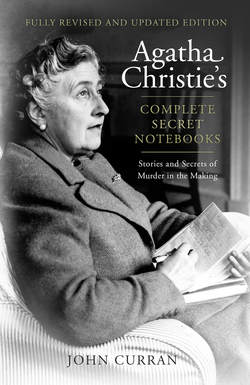Читать книгу Agatha Christie’s Complete Secret Notebooks - Агата Кристи, Agatha Christie, Detection Club The - Страница 28
… something scribbled down …
ОглавлениеBefore discussing the handwriting in the Notebooks, it is only fair to emphasise that these were working notes and jottings; there was no reason to make an effort to maintain a certain standard of calligraphy as no one but Christie herself was ever intended to read them. These were, essentially, personal journals and not written for any purpose other than to clarify her thoughts.
Our handwriting changes as we age and scrambled notes of college or university days soon overtake the copperplate efforts of our early school years. Accidents, medical conditions and age all take their toll on our writing. In most cases it is safe to assert that as we get older our handwriting deteriorates. In the case of Agatha Christie the opposite is the case. At her creative peak (roughly 1930 to 1950) her handwriting is almost indecipherable. It looks, in many cases, like shorthand and it is debatable if even she could read some sections of it. I have no doubt that the reason for this was that, during these hugely prolific years, her fertile brain teemed with ideas and it was a case of getting them on to paper as fast as possible. Clarity of presentation was a secondary consideration.
The conversion of the Notebooks into an easily readable format, for the purposes of this book, took over six months. A detailed knowledge of all of Dame Agatha’s output was not just an enormous help but a vital necessity. It helped to know, for instance, that a reference to ‘apomorphine’ is not a misprint, a mistake or a mis-spelling but a vital part of the plot of Sad Cypress. But it did not help in the case of notes for an unpublished title or for discarded ideas. As the weeks progressed I was surprised how used to the handwriting I became, so that converting the last batch of Notebooks was considerably quicker than the first. I also discovered that if I left a seemingly indecipherable page and returned to it a few days later, I could often make sense of it. But some words or sentences still defied me and in a number of cases I had to resort to an educated guess.
From the late 1940s onwards the handwriting steadily ‘improved’ so that by the early 1950s and, for example, After the Funeral in Notebook 53, the notes are quite legible. Agatha Christie was ruefully aware of this herself. In November 1957, in a letter about Ordeal by Innocence, she writes, ‘I am asking Mrs. Kirwan [her secretary Stella Kirwan] to type this to you knowing what my handwriting is like’, and again in August 1970 she describes her own handwriting as ‘overlarge and frankly rather illegible’. And she writes this after the improvement!
For some years, there has been a theory in the popular press that Agatha Christie suffered from dyslexia. I have no idea where this originated but even a cursory glance at the Notebooks gives the lie to this story. The only example that could be produced in evidence is her struggle with ‘Caribbean’ and ‘Carribean’ throughout the notes for A Caribbean Mystery: but I think in that she would not be alone!
